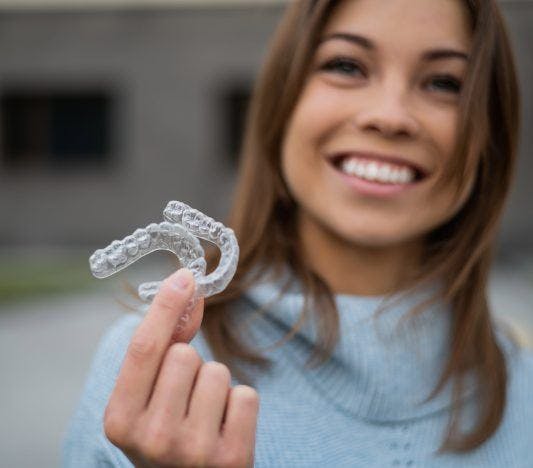Are you after a picture-perfect smile, but crooked teeth are getting in the way? If the answer is yes, it’s worth speaking to your dentist, as misaligned teeth could be a sign of more than just an aesthetic issue.
The good news is there are plenty of options available to address any deeper issues. Read on to uncover everything from the causes, issues, and treatment options available for crooked teeth.
What are crooked teeth?

Crooked or misaligned teeth are when teeth are out of place – bent, twisted, jutting out, overcrowding, or overlapping. Sometimes, just a single tooth might be misaligned, while other times, a whole row can be in disarray.
As teeth naturally shift over time and various factors influence their positioning, misalignment can occur. Crooked teeth often bring along challenges like discomfort while chewing, asymmetrical facial features, and speech difficulties.
Take this online smile assessment, which shows the different types of teeth misalignments.
What causes crooked teeth?
Are crooked teeth hereditary, or are they a result of your lifestyle choices? It could be a bit of both! Here are some possible causes of misaligned teeth:
Genetics
Crooked teeth can run in the family, confirms a Global Medical Genetics study. If one or both of your parents have crooked or crowded teeth, chances are you might get them, too. You could also inherit jaw and bite issues, like underbites or overbites, from them.
Childhood habits
Thumb-sucking, tongue thrusting, or prolonged use of pacifiers and feeding bottles can lead to crooked teeth, confirms a Systematic Reviews in Pharmacy study. These habits put pressure on the gums and push teeth out of their natural position.
Injury or trauma
Accidents can significantly impact your teeth. Injuries from falls or sports can damage your teeth, causing them to become misaligned. Trauma to the mouth or jaw often leads to shifts in tooth positioning.
Poor oral habits
Your brushing and flossing habits (or the lack of) may be the culprits, reveals a 2021 study. Poor oral hygiene can lead to issues like gum disease, which may cause teeth to move out of position. Neglecting regular dental checkups can exacerbate these issues.
Loss of teeth
Premature loss of baby teeth can create spaces, leading remaining teeth to shift and crowd. In adults, losing a tooth can cause neighbouring teeth to move into the gap, disrupting alignment.
Nutrition
A deficiency in certain nutrients may affect the proper development of your bones and teeth.
9 issues caused by crooked teeth
If left unchecked, your misaligned teeth may lead to more problems that can affect your daily life.
1. Gum disease
Crooked teeth are harder to brush, let alone floss, given that the spaces between are tighter and some surfaces may overlap. If you’re not thorough with your dental hygiene, you might experience problems, such as cavities and plaque buildup.
2. Difficulty chewing
Crowded teeth, which could also lead to crookedness, are the primary culprits behind malocclusion, which is the misalignment of your teeth. When either your upper or lower jaw protrudes, you have a harder time chewing and swallowing. It can also increase the possibility of choking.
3. Bad breath

Because crooked teeth give bacteria more places to hide and develop, it also makes you more prone to bad breath. Visit your dentist regularly to ensure every nook and cranny in your mouth is clean. Also, be diligent with oral care practices, such as brushing your teeth, flossing, and using mouthwash.
4. Heart problems
Crooked teeth could lead to conditions beyond the usual oral concerns. Bacteria from plaque buildup could get into your bloodstream and cause problems with your heart valves. Plaque and tartar also make you more prone to gum disease. While further study is needed, the American Dental Association confirms a link between gum disease and heart problems, along with other ailments like stroke, diabetes, and pneumonia.
5. Headaches

Stress, peckishness, lack of sleep, and hormonal changes might be some possible reasons behind your frequent headaches. However, another cause could be the pressure on your jaw muscles from overcrowded teeth constantly rubbing together. Any added strain on your face, neck, or temples can cause your head to hurt. Instead of grabbing some painkillers, reach for the mobile and set an appointment with an orthodontist.
6. Jaw pain
What happens if crooked teeth are left untreated? When you have misaligned teeth, the force you exert when biting or chewing becomes uneven, too. One side might be receiving more pressure that can cause your jaw and related muscles to ache. This leads to temporomandibular disorders (TMD), and that pain can extend to your face, neck, and shoulders. You might even experience frequent jaw locking and popping.
7. Risk of tooth injuries
Protruding crooked front teeth are more likely to chip or crack in the eventuality of an accident. In addition, strained jaw muscles put excess pressure on your teeth, increasing the risk of tooth breakage.
8. Teeth grinding
Bruxism, or teeth grinding, is more common in people with crooked teeth or malocclusion. This condition can wear down the enamel of your teeth, cause tooth loss, disrupt sleep, and lead to TMD.
9. Confidence woes
The 2021 paper Psychological and Social Effects of Oral Health and Dental Aesthetic in Adolescence and Early Adulthood confirms what you might have already suspected. Crooked teeth, bad breath, and other oral problems affect self-perception, self-esteem, and quality of life, especially in younger women.
Moreover, more research shows a correlation between perceived attractiveness and the broadness of your smile.
What are the options for straightening crooked teeth?
These problems aren’t worth the trouble, when there are plenty of solutions to crooked teeth. Here are some options:
Braces
Traditional metal braces use wires and brackets to gradually shift teeth into proper alignment. They are highly effective but can cause discomfort and self-consciousness due to their visibility.
Clear aligners
Go for custom clear aligner trays if you want something as effective as braces but more comfortable and discrete.
ClearCorrect aligners are even more stain-resistant than other brands, thanks to its proprietary ClearQuartz tri-layer material. It delivers greater control and consistent force application to achieve complex movements more predictably. It also has a high trimline that makes it look natural – no awkward full mouth metal flashbacks here.
Surgery
For severe cases, surgical intervention may be necessary to correct jaw alignment or bite issues. This option is typically considered when other treatments are not sufficient to achieve the desired results.
Palatal expanders
These devices correct crookedness by widening the upper jaw, creating space for crowded teeth to align properly. These are ideal for younger patients whose bones are still growing.
With a bit of dental help, your crooked teeth will soon be a memory. Visit your dentist soon to find the most suitable solution for a more confident smile and optimum oral health.
References:
American Dental Association. (n.d.). Heart Disease and Oral Health. Mouth Healthy.
Cocca, S., Viviano, M., Loglisci, M., Parrini, S., Monciatti, G., Paganelli, I. I., Livi, W., & Mezzedimi, C. (2019). Correlation Between Dysphagia and Malocclusion in Rett Syndrome: A preliminary study. Sultan Qaboos University Medical Journal, 18(4), 489.
Horn, S., Matuszewska, N., Gkantidis, N., Verna, C., & Kanavakis, G. (2021b). Smile dimensions affect self-perceived smile attractiveness. Scientific Reports, 11(1).
Militi, A., Sicari, F., Portelli, M., Merlo, E. M., Terranova, A., Frisone, F., Nucera, R., Alibrandi, A., & Settineri, S. (2021). Psychological and Social Effects of Oral Health and Dental Aesthetic in Adolescence and Early Adulthood: An Observational Study. International Journal of Environmental Research and Public Health, 18(17), 9022.
Neela, P. K., Atteeri, A., Mamillapalli, P. K., Sesham, V. M., Keesara, S., Chandra, J., Monica, U., & Mohan, V. (2020). Genetics of dentofacial and orthodontic abnormalities. Global Medical Genetics, 07(04), 095–100.
Wang, Z., Feng, J., Wang, Q., Yang, Y., & Xiao, J. (2021). Analysis of the correlation between malocclusion, bad oral habits, and the caries rate in adolescents. Translational Pediatrics, 10(12), 3291–3300.



